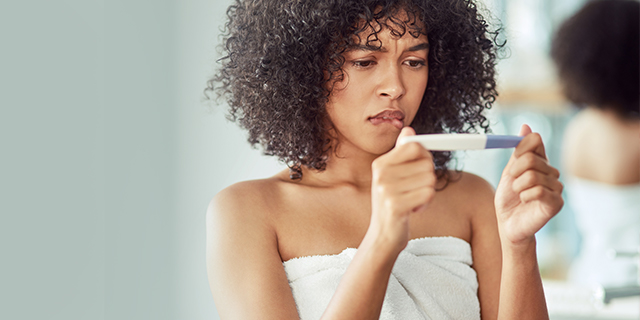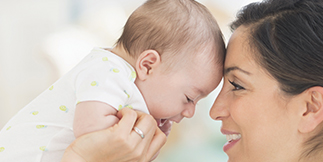Week 2 – Conception
Conception usually happens in the fallopian tube and although it is by any standards a significant moment, there are no outward signs that fertilisation has occurred. Generally, it takes around 6-12 days for the fertilised egg to travel down the fallopian tube to your womb.
With a couple of well-timed interventions and a little luck, you and your partner will be able to make the most of your chances of successful conception.
During week 2 of your cycle, some essential and complex processes are happening within your brain and reproductive organs. This is the start of what could be a series of events leading to your baby becoming a reality.
Ovulation
Each month one of your two ovaries releases an egg. This is alternated from left to right and in some women more than one egg is released in each monthly cycle. The egg sits in a “bed” of fluid, known as a follicle.
The follicle is influenced by a specific hormone telling it when to rupture so the egg can be picked up by the fallopian tube. Although many follicles start the process of maturing an egg each month, only one dominant one, from a field of about 20, will make it out.
While your follicles are busy maturing an egg, they also release oestrogen to “switch on” the process of preparing your womb to receive a fertilised egg.
If fertilisation of your egg with your partner’s sperm doesn’t occur, the blood-thickened lining inside your womb will not be needed and is shed in your next period. This usually happens 2 weeks after ovulation.
When will I ovulate?
Most women have cycles that last 28-32 days, although a couple of days either side of this is still considered normal. Ovulation usually occurs on or around the 14th day after the first day of your last period. In women with longer or shorter cycles than the standard 28 days, ovulation timing will be different.
How can I tell when I ovulate?
What’s happening inside your body:
There are to the cervical mucus, which is designed to assist the sperm to swim up through the cervix towards the egg. Fertile mucus looks like egg white, and is more watery and slippery than usual.
An increased basal body temperature. A woman’s temperature rises a couple of degrees from her baseline temperature when she is ovulating. Charting your temperature for a couple of months will help you see a pattern developing, which can help you figure out when you are at your most fertile.
Saliva and urine tests available at pharmacies, can detect hormonal changes and alert you to the fact that you have ovulated.
There are also some subtle external changes when you are ready to ovulate:
Some women develop a heightened sense of smell or sensitivity to odours they aren’t usually conscious of.
Pain in the pelvic region. Some women develop an increased libido and feel more sensual towards their partner. At some biological level this is nature’s way of encouraging couples to have sex at the most fertile time of a woman’s cycle.
An egg is capable of being fertilised for around 12-24 hours after it has been released from its follicle. Sperm can live for much longer, around 3-5 days. This means they can lie in wait for a few days, biding their time, until the opportunity presents itself for successful fertilisation.
So if you are trying to fall pregnant, it is worthwhile to time conception to fall within a few days either side of ovulation.
Fertilisation
Fertilisation of the egg with a single sperm results in a zygote (single cell) and usually occurs in the fallopian tube in the 3rd week of pregnancy.
It is important that this zygote continues to move down the fallopian tube towards the womb, because it starts to divide quickly and the cells multiply. If it implants itself in the fallopian tube, an ectopic pregnancy occurs where there is no room in the microscopic tubes to accommodate it.
It takes two to make a baby
Fascinating and complex as it all is, ovulation is only one half of the story when it comes to making a baby. When your partner ejaculates, around 100-300 million sperm are present in his seminal fluid. But it only takes one sperm to fertilise your egg and from that precise moment, all of the other sperm give up trying.
Don’t worry if you don’t conceive in the first month of trying. It can take a while to get to know your cycles and when your most fertile time is likely to be. There is only around a 20% chance of falling pregnant each month and it takes many couples up to 12 months or more to conceive.
Your physical changes this week
Refer back to week 1 for signs that you have ovulated or are about to. Keep a calendar and mark the dates of your last period, when it started and ended. Ovulation usually happens some time midway between the menstrual cycles.
Your emotional changes this week
You may feel more amorous, have a higher libido or just find your partner more attractive than you usually do. Somehow, those irritating little habits of his just don’t seem to matter anymore. Well, not for this week anyway.
Your baby’s genetic information is contained in the single cell you will release from one of your ovaries midway between your cycles.
Hints for the week
If you’re a smoker, quit the habit now. Nicotine can affect fertility and reduce the likelihood of conceiving in some women.
If you want to conceive, make plans to have some intimate time to have sex with your partner. In our busy lives this can sometimes take some planning and organisation.
Don’t forget you need to start taking pre-natal vitamins that include folic acid. The recommended dose of folic acid in early pregnancy is 500 mcg/day.
Now, on to week 3 when you are really going to feel you’re getting somewhere.
























